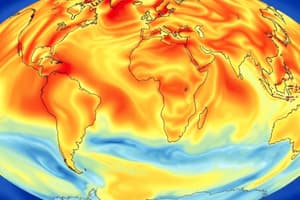Podcast
Questions and Answers
What is Sea Surface Temperature (SST) and how is it typically measured?
What is Sea Surface Temperature (SST) and how is it typically measured?
SST is the temperature of the top layer of the ocean, usually measured at a depth of about 1 meter, using buoys, ships, or satellites.
Discuss the significance of SST in climate studies.
Discuss the significance of SST in climate studies.
SST is a key indicator of climate change and trends, affecting weather patterns and marine ecosystems.
Identify three factors that can affect Sea Surface Temperature.
Identify three factors that can affect Sea Surface Temperature.
Solar radiation, ocean currents, and atmospheric conditions can affect SST.
Explain the role of SST in weather forecasting.
Explain the role of SST in weather forecasting.
How does SST data contribute to fisheries management?
How does SST data contribute to fisheries management?
What are the implications of increasing SST in the context of global warming?
What are the implications of increasing SST in the context of global warming?
Describe how seasonal changes affect Sea Surface Temperature.
Describe how seasonal changes affect Sea Surface Temperature.
What technological methods are employed to measure SST from space?
What technological methods are employed to measure SST from space?
Differentiate between SST variability in tropical zones and polar regions.
Differentiate between SST variability in tropical zones and polar regions.
What organizations are major sources for Sea Surface Temperature data?
What organizations are major sources for Sea Surface Temperature data?
Study Notes
SST (Sea Surface Temperature)
-
Definition:
- Sea Surface Temperature (SST) refers to the temperature of the top layer of the ocean, typically measured at a depth of about 1 meter.
-
Measurement:
- SST can be measured using various methods:
- Buoys: Floating devices equipped with sensors.
- Ships: Instruments on research vessels.
- Satellites: Remote sensing technology providing large-scale measurements.
- SST can be measured using various methods:
-
Importance:
- Climate Studies: Key indicator of climate change and trends.
- Weather Forecasting: Influences atmospheric conditions; affects precipitation and storm formation.
- Marine Ecosystems: Critical for the health and distribution of marine species; affects breeding and feeding patterns.
-
Factors Affecting SST:
- Solar Radiation: Primary driver of SST; warmer in equatorial regions.
- Ocean Currents: Distributes heat across oceans; influences local temperatures.
- Atmospheric Conditions: Wind patterns and humidity can affect surface temperatures.
- Seasonal Changes: Varies with seasons; warmer in summer, cooler in winter.
-
Applications:
- Fisheries Management: Helps assess fish populations and migration patterns.
- Climate Models: SST data is integrated into climate models for predictions and assessments.
- Natural Disasters: Plays a role in predicting phenomena like hurricanes and El Niño events.
-
Data Sources:
- NOAA (National Oceanic and Atmospheric Administration)
- NASA (National Aeronautics and Space Administration)
- Various international oceanographic institutes.
-
Global Variability:
- SST can vary significantly across different regions:
- Tropical Zones: Warmest temperatures.
- Polar Regions: Coldest temperatures.
- Mid-latitude Regions: Seasonal variations are more pronounced.
- SST can vary significantly across different regions:
-
Trends:
- Increasing SST is linked to global warming.
- Monitoring trends is essential for understanding climate change impacts.
-
Technology:
- Advances in remote sensing and satellite technology have improved accuracy and coverage of SST data.
-
Research Areas:
- Ongoing studies on the impact of SST on weather patterns, marine life, and global climate systems.
Sea Surface Temperature (SST) Overview
- Sea Surface Temperature indicates the temperature of the ocean's top layer, measured about 1 meter deep.
Measurement Methods
- Buoys: Floating instruments that record temperature using sensors.
- Ships: Research vessels equipped with specialized instruments for temperature measurement.
- Satellites: Utilize remote sensing technology to collect extensive SST data across large areas.
Importance of SST
- Climate Studies: Provides crucial insights into climate change dynamics and trends.
- Weather Forecasting: Influences atmospheric conditions, impacting precipitation and storm development.
- Marine Ecosystems: Vital for the health and distribution of marine life, affecting breeding and feeding behaviors.
Factors Influencing SST
- Solar Radiation: Major contributor to SST, with temperatures higher in equatorial regions.
- Ocean Currents: Assist in heat distribution, shaping local sea temperatures.
- Atmospheric Conditions: Winds and humidity levels can modify surface temperatures.
- Seasonal Changes: SST experiences fluctuations, being warmer in summer and cooler in winter.
Applications of SST Data
- Fisheries Management: Essential for assessing fish populations and migration trends.
- Climate Models: SST data is integral to climate models for future predictions and evaluations.
- Natural Disasters: Crucial in forecasting events like hurricanes and El Niño phenomena.
Data Sources
- NOAA: National Oceanic and Atmospheric Administration, responsible for monitoring ocean conditions.
- NASA: National Aeronautics and Space Administration contributes satellite data.
- International Oceanographic Institutes: Various organizations collect and analyze SST data globally.
Global Variability
- SST varies widely across different geographical regions:
- Tropical Zones: Experience the warmest temperatures.
- Polar Regions: Characterized by the coldest temperatures.
- Mid-latitude Regions: Exhibit pronounced seasonal temperature variations.
Trends in SST
- Increasing SST correlates with global warming, making monitoring crucial for understanding climate change effects.
Technological Advances
- Innovations in remote sensing and satellite capabilities enhance the precision and coverage of SST measurements.
Ongoing Research Areas
- Studies focus on SST's impact on weather patterns, marine ecosystems, and the overarching global climate system.
Studying That Suits You
Use AI to generate personalized quizzes and flashcards to suit your learning preferences.
Description
This quiz explores the concept of Sea Surface Temperature (SST), detailing its definition, measurement methods, and significance in climate studies. Dive into the importance of SST in understanding ocean dynamics and climate change.



